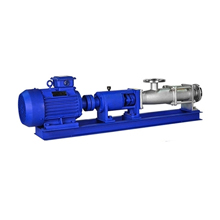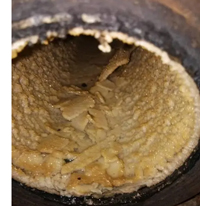Screw Pump Troubleshooting
Screw pump is a commonly used centrifugal pump. It has the advantages of simple structure, stable operation and large flow rate, and is widely used in industrial production. However, during use, screw pumps will also encounter some common faults that affect their normal operation. This article will analyze and summarize the common faults and solutions of screw pumps.
Screw Pump Leakage Fault

Screw pump leakage refers to the unintended release of the working fluid from the pump into the external environment. This issue is mainly caused by the following factors:
- Seal Aging: Seals in screw pumps can deteriorate over extended periods of operation, leading to reduced sealing performance and resulting in leaks. The solution is to periodically replace the seals to ensure their sealing effectiveness.
- Pump Casing Wear: In screw pumps, there is a gap between the inner wall of the pump casing and the blades. Severe wear of the pump casing can widen this gap, causing leaks. The solution is to regularly inspect the pump casing for wear and promptly replace heavily worn components.
- Blade Wear: The blades in screw pumps are the primary working components within the pump. Prolonged usage can lead to blade wear and consequent leaks. The solution is to periodically check the condition of the blades and promptly replace severely worn ones.
Excessive Temperature in Screw Pump
During operation, screw pumps generate heat due to friction and internal energy losses. In cases where the pump cannot effectively dissipate this heat, it can overheat, affecting its normal operation. The primary reasons for excessive temperature in screw pumps include:
- Pump Casing Blockage: If impurities or solid particles are present inside the pump casing during operation, it can lead to blockages, hindering heat dissipation. The solution is to regularly clean the interior of the pump casing to maintain unobstructed flow.
- Insufficient Lubrication: Screw pumps rely on lubricating oil for both lubrication and cooling. Inadequate lubrication can lead to elevated pump temperatures. The solution is to regularly check the lubricating oil level and promptly replenish it.
- Bearing Damage: Bearings within screw pumps are crucial components, and their damage can result in increased pump temperatures. Regular inspections to detect bearing wear and prompt replacement of damaged bearings are essential to prevent overheating.
Screw Pump Flow Instability Fault
During the operation of a screw pump, flow instability may occur, characterized by fluctuations in flow rate or an inability to meet design requirements. The main causes of flow instability in a screw pump are as follows:
Clogged pipe
- Improper Inlet Valve Opening: Incorrect adjustment of the inlet valve in a screw pump can lead to flow rate instability. The solution is to adjust the opening of the inlet valve based on actual operating conditions to align with the work requirements.
- Inlet Pipe Blockage: Blockages in the inlet pipe of a screw pump can result in flow rate instability. Regular cleaning to remove impurities and maintain a clear inlet pipe is essential to keep the pipeline unobstructed.
- Uneven Blade Wear: Non-uniform wear of the blades in a screw pump can lead to flow rate instability. The solution is to periodically inspect the condition of the blades and promptly replace severely worn blades.
In the course of using screw pumps, common issues such as leakage, elevated temperatures, and flow instability may arise. To address these problems, it is crucial to conduct regular inspections and maintenance of components like seals, the pump casing, and blades to ensure their proper operation. Additionally, attention should be given to the heat dissipation within the pump and the cleanliness of internal components to enhance the operational efficiency and lifespan of screw pumps.
Pump Fails to Start Properly
- Problem: Power supply faults, motor malfunctions, blockages within the pump, or wear and tear of internal pump components.
- Solution: Begin by checking the power supply and the motor to confirm their proper functioning. If the power supply and motor are in working order, inspect the pump for any internal blockages and clear them. If wear and tear of internal components is preventing the pump from starting correctly, these worn parts should be replaced.
Abnormal Pump Operation
- Problem: overheating of the pump's internal medium, the internal medium being too cold, damage to internal pump components, or severe wear and tear of these components.
- Solution: Initially, check whether the temperature of the pump's internal medium is within the normal range. If it is excessively hot or cold, adjust the medium's temperature accordingly. If damaged or significantly worn internal components are the reason for abnormal pump operation, the corresponding parts should be replaced.
Low Outlet Pressure
- Problem: Insufficient pump speed, changes in the density of the pump's internal medium, or wear and blockages of internal pump components.
- Solution: Start by checking whether the pump speed is within the normal range. If it is too low, adjust the pump speed accordingly. If changes in the density of the pump's internal medium are causing low outlet pressure, adjust the medium's density. If wear and blockages of internal components within the pump are the culprits, replace the relevant parts or clear the blockages.
Excessive Noise or Severe Vibration in the Pump
- Problem: Loose internal components of the pump, non-uniformity in the pump's internal medium, or an unstable foundation of the pump.
- Solution: Begin by checking whether internal components within the pump are loose. If they are, secure them properly. If non-uniformity in the pump's internal medium is causing excessive noise or severe vibration, adjust the medium's flow rate. If an unstable pump foundation is leading to excessive noise or severe vibration, reinforce the pump's foundation.
Troubleshooting screw pump issues is crucial for maintaining efficient industrial processes and preventing costly downtime. By understanding the common problems associated with screw pumps and following the suggested solutions, you can keep your equipment running smoothly and extend its lifespan. Regular maintenance and monitoring of your screw pump can help identify issues early and prevent major breakdowns, ensuring the reliable and consistent operation of your industrial processes. If you have any questions, you can come to the ATO for consultation and we will be happy to answer your questions.

